Definition. Let ![]() , ...
, ... ![]() be real numbers, with
be real numbers, with
![]() , ...,
, ..., ![]() positive. A finite continued
fraction is an expression of the form
positive. A finite continued
fraction is an expression of the form
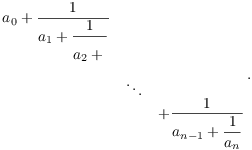
To make the writing easier, I'll denote the continued fraction above
by ![]() . In most cases,
the
. In most cases,
the ![]() 's will be integers.
's will be integers.
Remark. In some cases people have considered continued fractions where the numerators don't have to be 1. For example,

In this case, they refer to continued fractions where the numerators are all 1 as simple continued fractions.
I will only be considering continued fractions where the numerators are all 1. So to save writing, I won't use the adjective "simple", and use the phrase "continued fraction" to mean a continued fraction with numerators all eqaul to 1.
Example. Find a continued fraction expansion
for ![]() .
.
I can do this by repeated division:

In short form, ![]() .
.
Now repeated division is what you do in executing the Euclidean algorithm and so a little bit of thought should convince you that you can express any rational number as a finite continued fraction in this way. Specifically,
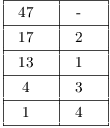
Notice that the successive quotients 2, 1, 3, and 4 are the numbers
in the continued fraction expansion.![]()
Example. Find a finite continued fraction
expansion for ![]() .
.
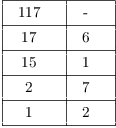
![$$\dfrac{117}{17} = [6; 1, 7, 2] = 6 + \dfrac{1}{1 + \dfrac{1}{7 + \dfrac{1}{2}}}.\quad\halmos$$](finite-continued-fractions15.png)
I have been asking for a finite continued fraction expansion, not the finite continued fraction expansion. In fact, the continued fraction expansion of a rational number is not unique. For example,

And in general,
![]()
Lemma. Every finite continued fraction with integer terms represents a rational number.
Proof. If ![]() , then
, then ![]() is rational.
is rational.
Inductively, suppose that a finite continued fraction with ![]() "levels" is a rational number. I
want to show that
"levels" is a rational number. I
want to show that
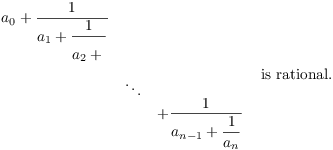
By induction,
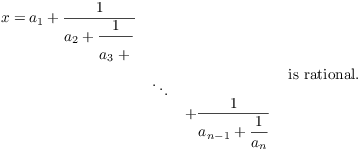
So
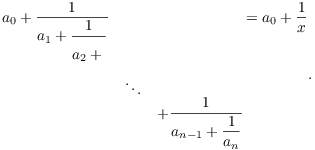
This is the sum of two rational numbers, which is rational as
well.![]()
I'd like eventually to discuss infinite continued fractions --- things that look like
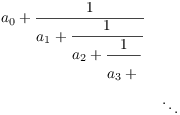
In preparation for this, I'll look at the effect of truncating a continued fraction.
Definition. The ![]() convergent of the
continued fraction
convergent of the
continued fraction ![]() is
is
![]()
Note that for ![]() ,
, ![]() .
.
Example. Find the first four convergents of
![]() .
.
![]()
![]()


And ![]() as
well.
as
well.![]()
It is tedious to have to compute convergents by doing the algebra to
simplify an enormous fraction. The next result gives an algorithm for
computing the convergents of a continued fraction. It's important for
theoretical reasons, too --- I'll need it for several of the proofs
that follow. For the theorem, I won't assume that the ![]() 's are integers, since I will need the general result
later on.
's are integers, since I will need the general result
later on.
Theorem. Let ![]() , where
, where ![]() and
and ![]() . Let
. Let
![]()
![]()
![]()
Then the k-th convergent of ![]() is
is ![]() .
.
Proof. First, note that
![$$\raise0.61in\hbox{$[b_0; b_1, \ldots, b_k, b_{k + 1}] =$} \matrix{b_0 + \dfrac{1}{b_1 + \dfrac{1}{b_2 + \vphantom{\dfrac{1}{b_3}}}} & & \cr & \ddots & \cr & & + \dfrac{1}{b_{k - 1} + \dfrac{1}{b_k + \dfrac{1}{b_{k + 1}}}} \cr} \raise0.61in\hbox{$= \left[b_0; b_1, \ldots, b_k + \dfrac{1}{b_{k + 1}}\right]$}.$$](finite-continued-fractions45.png)
I got this by regarding the last two terms as a single term.
Note also that ![]() , ...,
, ..., ![]() and
and ![]() , ...,
, ..., ![]() are the same for
these two fractions, since they only differ in the k-th term.
are the same for
these two fractions, since they only differ in the k-th term.
Now I'll start the proof --- it will go by induction on k. For ![]() ,
,
![]()
And for ![]() ,
,
![]()
Suppose ![]() , and assume that result holds
through the k-th convergent. Then
, and assume that result holds
through the k-th convergent. Then
![]()
Now this is the k-th convergent of a continued fraction, so by
induction this is ![]() , where
, where
![]() and
and ![]() refer to
refer to ![]() (as opposed to
(as opposed to ![]() ). But what are the
). But what are the
![]() and
and ![]() for this fraction? They're given inductively by
for this fraction? They're given inductively by
![]()
Now ![]() ,
, ![]() ,
, ![]() ,
, ![]() are the same for
are the same for ![]() and
and ![]() , as I noted at the start. On the other hand, the
k-th term of
, as I noted at the start. On the other hand, the
k-th term of ![]() is
is ![]() . So
. So

(The next to the last equality also follows by induction.) This shows
that the result holds for ![]() , so the induction
step is complete.
, so the induction
step is complete.![]()
Example. Compute ![]() for
for ![]() .
.
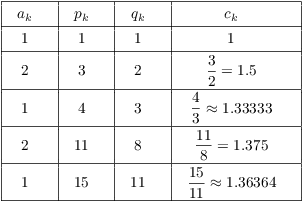
There is a pattern to the computation of the p's and q's which makes things pretty easy. To get the next p, for instance, multiply the current a by the last p and add the next-to-the-last p.
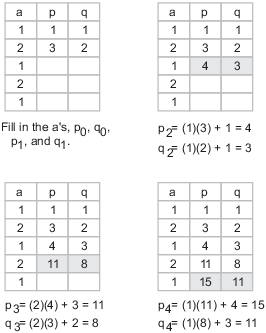
Notice that in the last example, the convergents oscillate, and that the fractions which give the convergents are always in lowest terms. We'll see that this holds in general.
Example. Find ![]() for
for ![]() .
.
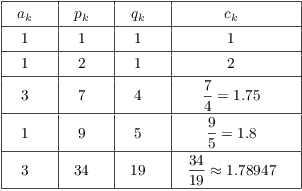
Again, notice that the convergents oscillate, and that the fractions
for the convergents are always in lowest terms.![]()
I'll prove that the convergent fractions are in lowest terms first.
Theorem. Let ![]() , where
, where ![]() and
and ![]() . Let
. Let
![]()
![]()
![]()
Then
![]()
Proof. I'll induct on k. For ![]() ,
,
![]()
Take ![]() , and assume the result holds for
k. Then
, and assume the result holds for
k. Then
![]()
![]()
This proves the result for ![]() , so the general result is true by
induction.
, so the general result is true by
induction. ![]()
Corollary. Let ![]() , where
, where ![]() and
and ![]() . Let
. Let
![]()
![]()
![]()
Then ![]() is in
lowest terms for
is in
lowest terms for ![]() .
.
Proof. ![]() implies that
implies that ![]() .
.![]()
Example. The Golden Ratio ![]() has the
infinite continued fraction expansion
has the
infinite continued fraction expansion ![]() .
.
(a) Find the first 10 convergents.
(b) Find an integer linear combination of 89 and 55 that is equal to 1.
(a)
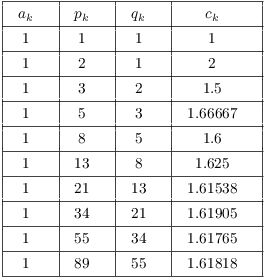
(You might have noticed that the p's and q's are the Fibonacci numbers!)
In fact, ![]() . In this case, you can see formally that
. In this case, you can see formally that ![]() should be
should be ![]() . Let
. Let


The roots are ![]() . Since the fraction is positive, take the positive root to obtain
. Since the fraction is positive, take the positive root to obtain
![]() .
.![]()
(b) Applying the Theorem to the last two rows of the table, I have
![]()
Copyright 2022 by Bruce Ikenaga